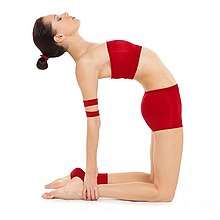Ustrasana
Ustrasana (Sanskrit: उष्ट्रासन; IAST: Uṣṭrāsana), Ushtrasana, or Camel Pose[1] is a kneeling back-bending asana in modern yoga as exercise.

Etymology and origins
The name comes from the Sanskrit words उष्ट्र Uṣṭra, "camel",[2] and आसन, Asana meaning "posture" or "seat".[3]
A different (standing) pose is given the name Ushtrasana in the 19th century Sritattvanidhi.[4] The modern pose is described in the 20th century by two of Krishnamacharya's pupils, Pattabhi Jois in his Ashtanga Vinyasa Yoga,[5] and B. K. S. Iyengar in his Light on Yoga.[6]
Description
Ustrasana is a deep backward bend from a kneeling position; the completed pose has the hands on the heels.[7] The backs of the feet may be flat on the floor, or the toes may be tucked under for a slightly less strong backbend.[8]
The pose is one of the 26 asanas in the Bikram Yoga sequence.[9]
Variations
The name Ardha Ustrasana, Half Camel pose, is given to two different poses. One has the hands on the hips;[10] the other has one hand on the heel on the same side, as in the full pose, and the other arm stretched back over the head.[11]
The pose can be modified by providing supports such as yoga bricks beside the calves for the hands.[8]
Claims
Twentieth century advocates of some schools of yoga, such as B. K. S. Iyengar, made claims for the effects of yoga on specific organs, without adducing any evidence.[12][13] Iyengar claimed that this pose would benefit "drooping shoulders and hunched backs".[14] He claimed that the "whole spine is stretched and toned".[14]
See also
References
- "Yoga Journal - Camel Pose". Retrieved 11 April 2011.
- "Dhanurasana". AshtangaYoga. Archived from the original on 29 April 2011. Retrieved 11 April 2011.
- Sinha, S. C. (June 1996). Dictionary of Philosophy. Anmol Publications. p. 18. ISBN 978-81-7041-293-9.
- Sjoman 1999, p. 77; plate 9, pose 54.
- Sjoman 1999, pp. 100-101.
- Iyengar 1979, pp. 87-88.
- Pizer, Ann (7 February 2019). "How to Do Camel Pose (Ustrasana) in Yoga". Very Well Fit. Retrieved 25 April 2019.
- Swanson, Ann (2019). Science of yoga : understand the anatomy and physiology to perfect your practice. New York, New York: DK Publishing. pp. 76–79. ISBN 978-1-4654-7935-8. OCLC 1030608283.
- "26 Bikram Yoga Poses". Bikram Yoga Poses Guide. Retrieved 25 April 2019.
- "Camel pose modifications, half Camel pose for beginners, ardha ustrasana steps and benefits". Vishwanti Yoga. Retrieved 26 July 2019.
- "Half Camel | Ardha Ustrasana". Yoga Basics. Retrieved 26 July 2019.
- Newcombe 2019, pp. 203-227, Chapter "Yoga as Therapy".
- Jain 2015, pp. 82–83.
- Iyengar 1979, p. 88.
Sources
- Iyengar, B. K. S. (1979) [1966]. Light on Yoga: Yoga Dipika. Unwin Paperbacks. ISBN 978-1855381667.CS1 maint: ref=harv (link)
- Jain, Andrea (2015). Selling Yoga : from Counterculture to Pop culture. Oxford University Press. ISBN 978-0-19-939024-3. OCLC 878953765.CS1 maint: ref=harv (link)
- Newcombe, Suzanne (2019). Yoga in Britain: Stretching Spirituality and Educating Yogis. Bristol, England: Equinox Publishing. ISBN 978-1-78179-661-0.CS1 maint: ref=harv (link)
- Sjoman, Norman E. (1999) [1996]. The Yoga Tradition of the Mysore Palace. Abhinav Publications. ISBN 81-7017-389-2.
_from_Jogapradipika_1830_(detail).jpg)
